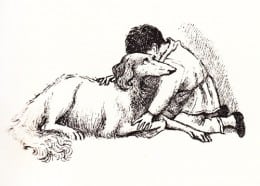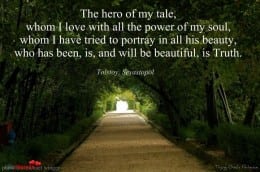 A few weeks ago, Tami Lewis Brown sent me a link and asked me if I had seen the borzoi illustrations Maurice Sendak had done for Nikolenka’s Childhood, Leo Tolstoy’s first publication and near autobiographical account of his childhood.
A few weeks ago, Tami Lewis Brown sent me a link and asked me if I had seen the borzoi illustrations Maurice Sendak had done for Nikolenka’s Childhood, Leo Tolstoy’s first publication and near autobiographical account of his childhood.
 Shamefully I had not and immediately placed an order. Via mail I received a collector’s copy of Nikolenka’s Childhood with Sendak’s signature prominently featured under his printed name.
Shamefully I had not and immediately placed an order. Via mail I received a collector’s copy of Nikolenka’s Childhood with Sendak’s signature prominently featured under his printed name.
 Although a million errands demanded my attention, I decided to cuddle up in bed under a down blanket with a movie-sized box of Milk Duds, a cup of chai, and my faithful borzoi and silken windhound to keep me company as I was transported to pre-Revolutionary Russia.
Although a million errands demanded my attention, I decided to cuddle up in bed under a down blanket with a movie-sized box of Milk Duds, a cup of chai, and my faithful borzoi and silken windhound to keep me company as I was transported to pre-Revolutionary Russia.
All I can say is, “Double Wow!”
 I wish I had discovered Nikolenka’s Childhood before Lara’s Gift went to print! Talk about authentic details I could have “borrowed” from Tolstoy like: wattle fence, abacus, the borzoi names “Milka” and “Zhiran,” fichu, caracole, nankeen coat, hussar, a calash, a britzka, vellum paper, Moscow clothes, tortoise-shell snuffbox, epaulets, turned-up little nose, game of robbers, birdlike face, scullion, hot iron pincers, use of “thou” and “thee,” mantilla, music of the quadrille, mazurka, drawing room, Hoffman’s drops, cornice, kutya, dropsy, unction, and tallow.
I wish I had discovered Nikolenka’s Childhood before Lara’s Gift went to print! Talk about authentic details I could have “borrowed” from Tolstoy like: wattle fence, abacus, the borzoi names “Milka” and “Zhiran,” fichu, caracole, nankeen coat, hussar, a calash, a britzka, vellum paper, Moscow clothes, tortoise-shell snuffbox, epaulets, turned-up little nose, game of robbers, birdlike face, scullion, hot iron pincers, use of “thou” and “thee,” mantilla, music of the quadrille, mazurka, drawing room, Hoffman’s drops, cornice, kutya, dropsy, unction, and tallow.
 Borzoi fans will not only savor chapters six thru seven, we will thank Tolstoy for planting us in an actual hunting scene and making us feel like we are also on the hunt. Unlike in Tolstoy’s War and Peace, readers experience a hunt from a childlike perspective and fully relate to Nikolenka’s desire to earn his father’s praise and the devastation he feels at failing in the hunt.
Borzoi fans will not only savor chapters six thru seven, we will thank Tolstoy for planting us in an actual hunting scene and making us feel like we are also on the hunt. Unlike in Tolstoy’s War and Peace, readers experience a hunt from a childlike perspective and fully relate to Nikolenka’s desire to earn his father’s praise and the devastation he feels at failing in the hunt.
Besides relishing the details in Tolstoy’s writing, along with Sendak’s lovely illustrations of borzoi and life on a Russian country estate, my favorite scene can be found in chapter seventeen entitled, “The Ivins,” for Tolstoy’s timeless and truthful approach in capturing Nikolenka’s desire to befriend Seryozha to the uncomfortable point where Nikolenka chooses to remain silent over Seryozha’s cruel treatment of another boy rather than question it and risk losing Seryozha as a friend.
What child doesn’t understand the fear and pain caused by a bully?

By chapter end, Nikolenka tries to make sense of “the only dark spot on the pages of his childhood recollections.”
I am quite unable to explain the cruelty of my behavior. Why did I not go up to him, protect, or console him? Where was the feeling of compassion which made me sob at the sight of a young jackdaw thrown from its nest, or of the puppy being taken to be thrown over the fence, or of a chicken the scullion was taking to make soup of? (108)
 There are many other moments of truth throughout Nikolenka’s Childhood that remind us of our own childhood and tap into a wide range of our emotions: sorrow, joy, hope, love, and loss. Tolstoy once said that, “fiction, in order to be successful, should come singing from the author’s soul.” In Nikolenka’s Childhood, we hear Tolstoy’s song on each page and in every word.
There are many other moments of truth throughout Nikolenka’s Childhood that remind us of our own childhood and tap into a wide range of our emotions: sorrow, joy, hope, love, and loss. Tolstoy once said that, “fiction, in order to be successful, should come singing from the author’s soul.” In Nikolenka’s Childhood, we hear Tolstoy’s song on each page and in every word.
For other great books about dogs, check out 101 Best Dog Books for Kids.
For published authors and unpublished authors, check out our writing contests.


